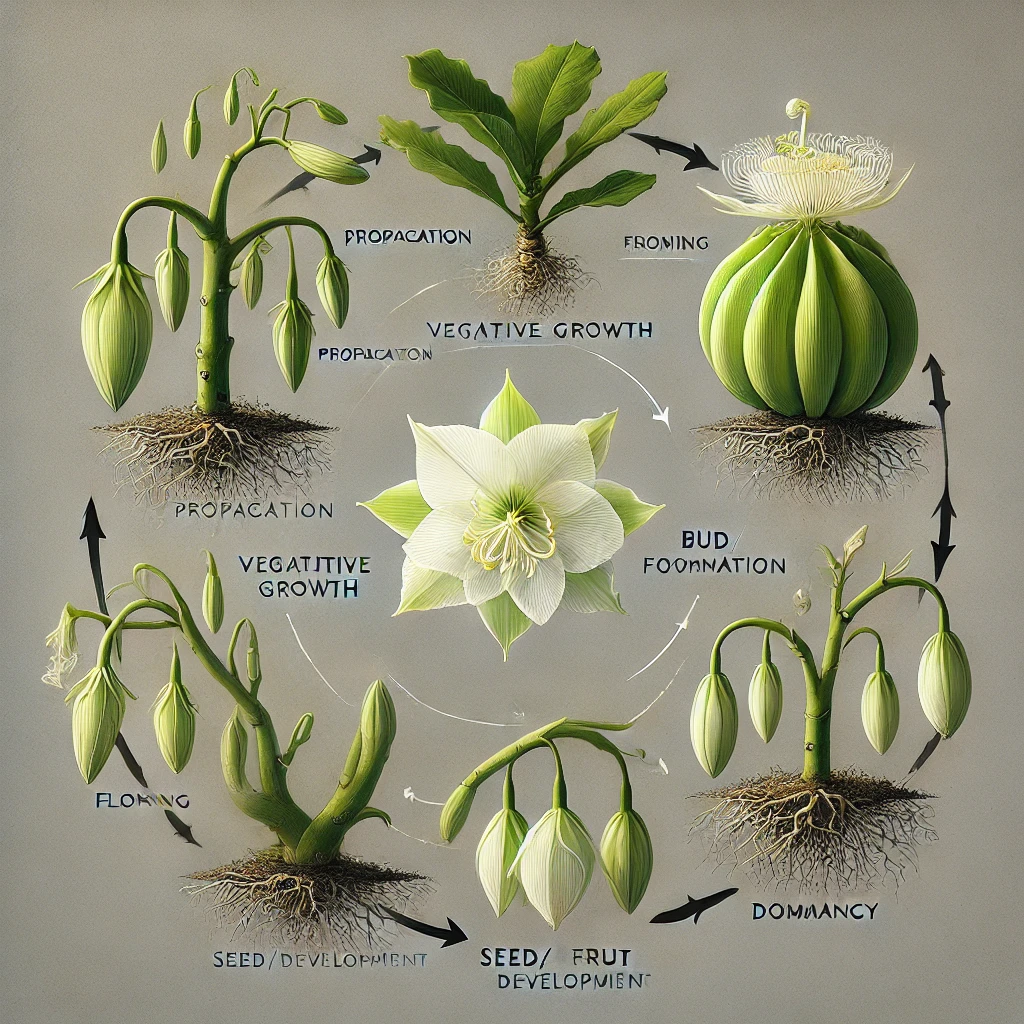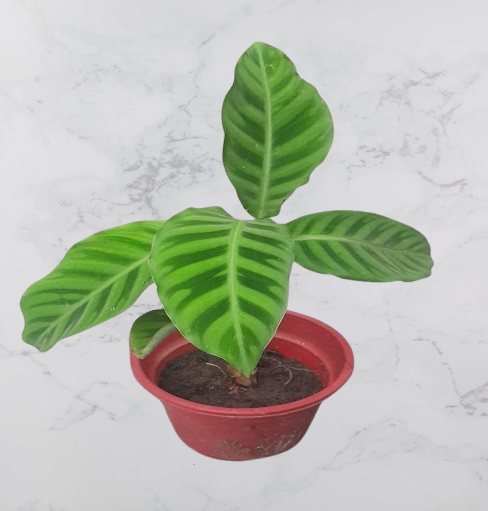The Queen of the Night refers to several flowering plants, most notably the Epiphyllum oxypetalum, a species of cactus known for its unique blooming habits and stunning flowers. Here’s a detailed look into everything about this fascinating plant:
Scientific Classification
- Kingdom: Plantae
- Order: Caryophyllales
- Family: Cactaceae
- Genus: Epiphyllum
- Species: Epiphyllum oxypetalum
Common Names
- Queen of the Night
- Orchid Cactus
- Night-blooming Cereus
- Dutchman’s Pipe
Physical Description
-
Stems:
- Flat, leaf-like stems (cladodes) that are green and photosynthetic.
- These stems can grow up to 12–36 inches long and act as the main structure of the plant.
-
Flowers:
- Large, fragrant, and trumpet-shaped, measuring up to 12 inches in diameter.
- Pure white petals with a yellow or cream-colored center.
- Flowers bloom only at night, typically between dusk and midnight.
- Blooms last only a single night, wilting before dawn.
-
Roots:
- Epiphytic roots that cling to trees or rocks. It can also grow in soil.
Habitat and Distribution
- Native Range: Southern Mexico and parts of Central and South America.
- Cultivation: Widely cultivated in tropical and subtropical regions, including India, Sri Lanka, Southeast Asia, and parts of the Caribbean.
- Environment: Thrives in warm, humid climates with indirect sunlight.
As an epiphytic cactus, it grows on trees or other surfaces, relying on its host for physical support but not nutrition.
Blooming Cycle
-
Frequency:
- Blooms are rare and unpredictable, typically occurring once a year.
- The plant often blooms in summer, influenced by temperature and humidity.
-
Timing:
- The flowers begin to open in the evening and are fully open by midnight.
- The bloom lasts just a few hours before wilting.
-
Pollination:
- Pollinated by nocturnal creatures like bats and moths attracted by its strong, sweet fragrance.
Cultural Significance
-
Symbolism:
- Often associated with purity, rarity, and fleeting beauty.
- Represents the transient nature of life due to its short-lived blooms.
-
Myths and Folklore:
- In many cultures, the Queen of the Night is seen as a lucky or spiritual plant.
- In India, it is called Brahma Kamal and is considered sacred, associated with the god Brahma.
Care and Cultivation
-
Light:
- Prefers bright, indirect sunlight.
- Direct sunlight can scorch its stems.
-
Soil:
- Requires well-draining soil, such as cactus or orchid mix.
-
Watering:
- Water moderately, allowing the soil to dry between waterings. Overwatering can lead to root rot.
-
Humidity:
- Thrives in high humidity but can adapt to indoor environments.
-
Propagation:
- Easily propagated by stem cuttings. Allow cuttings to callous for a day or two before planting.
-
Fertilizer:
- Use a balanced, diluted cactus fertilizer during the growing season (spring and summer).
Interesting Facts
-
Ephemeral Beauty:
Its fleeting bloom has inspired poets, writers, and artists. The anticipation of its rare bloom is celebrated by plant enthusiasts worldwide. -
Medicinal Uses:
In traditional medicine, parts of the plant are used to treat various ailments like swelling, respiratory issues, and diabetes. -
Highly Coveted:
Gardeners prize it for its stunning flowers and unique blooming habit.
Threats and Conservation
- Though it is not currently endangered, habitat destruction and climate change could threaten its natural populations.
- Cultivation in gardens and nurseries helps ensure its survival.
The Queen of the Night is a botanical wonder, celebrated for its mesmerizing nocturnal blooms. Its fleeting beauty teaches us to cherish transient moments and remains a symbol of nature’s magic.
Common Insects and Pests
-
Mealybugs
- Signs: White, cottony masses on stems and leaves. Sticky residue (honeydew) that can lead to sooty mold.
- Prevention: Maintain good air circulation and inspect new plants before bringing them home.
- Treatment:
- Remove visible bugs using a cotton swab dipped in alcohol.
- Use insecticidal soap or neem oil spray.
-
Spider Mites
- Signs: Fine webbing on stems and leaves, yellowing or speckled leaves.
- Prevention: Keep humidity levels high and regularly mist the plant.
- Treatment:
- Rinse the plant with water to dislodge mites.
- Apply miticides or horticultural oil.
-
Aphids
- Signs: Clusters of small, soft-bodied insects on new growth, leaves curling or yellowing. Sticky honeydew.
- Prevention: Encourage beneficial insects like ladybugs and lacewings.
- Treatment:
- Spray with a strong stream of water to remove aphids.
- Use neem oil or an insecticidal soap spray.
-
Scale Insects
- Signs: Small, brown or gray, immobile bumps on stems or leaves. Sticky honeydew and sooty mold.
- Prevention: Inspect plants regularly, especially under the leaves.
- Treatment:
- Gently scrape scales off with a toothbrush.
- Apply horticultural oil or systemic insecticides.
-
Snails and Slugs
- Signs: Ragged holes in leaves, silvery slime trails.
- Prevention: Keep the plant off the ground and use barriers like copper tape around pots.
- Treatment:
- Use organic snail bait or handpick snails at night.
- Sprinkle diatomaceous earth around the base of the plant.
-
Fungal Gnats
- Signs: Tiny, black flying insects hovering around the soil. Indicate overwatering.
- Prevention: Allow the soil to dry out between waterings.
- Treatment:
- Use sticky traps to catch adult gnats.
- Drench the soil with a diluted solution of hydrogen peroxide (1 part peroxide to 4 parts water).
Prevention Methods
-
Healthy Plant Practices:
- Avoid overwatering and ensure proper drainage.
- Use sterilized soil to reduce the risk of pests.
- Regularly clean and inspect the plant for early signs of pests.
-
Environmental Management:
- Maintain good air circulation around the plant.
- Keep the humidity balanced, as some pests thrive in dry conditions.
-
Companion Plants:
- Grow pest-repelling plants like marigolds or basil nearby to deter pests.
Chemical Treatments
For severe infestations, chemical pesticides may be necessary. Always follow the manufacturer’s instructions when using any chemical product.
-
Insecticidal Soap:
- Safe for most cacti and succulents. Effective against soft-bodied pests like aphids and mealybugs.
-
Neem Oil:
- A natural pesticide that disrupts pest life cycles. Spray thoroughly on affected areas every 7–10 days.
-
Systemic Insecticides:
- Products containing imidacloprid or dinotefuran are effective for long-term control of pests like scale and mealybugs. These are absorbed by the plant and protect it from the inside.
-
Miticides:
- For spider mites, use specific miticides containing abamectin or bifenazate.
-
Fungicides:
- To treat sooty mold caused by honeydew, use fungicides containing copper sulfate or sulfur.
-
Diatomaceous Earth:
- A natural, non-toxic option for controlling crawling pests like slugs and ants.
Key Tips When Using Chemicals
- Test on a small section of the plant first to ensure no adverse reaction.
- Avoid spraying during the hottest part of the day to prevent leaf burn.
- Wear gloves and protective gear when handling pesticides.
- Repeat treatments as needed to break the pest life cycle.



Life Cycle of the Queen of the Night Plant (Epiphyllum oxypetalum)
The Queen of the Night, a tropical epiphytic cactus, has a fascinating life cycle influenced by its environment and seasonal changes. Below is its life cycle, from propagation to flowering and reproduction:
1. Propagation Stage (Birth)
-
Method:
- Natural Propagation: Seeds dispersed from pollinated flowers germinate in suitable conditions.
- Artificial Propagation: Most commonly propagated by stem cuttings.
-
Process:
- Stem cuttings are allowed to callous (dry) for 1–2 days and then planted in well-draining soil.
- Roots develop within 2–4 weeks under warm, moist conditions.
-
Duration:
- Germination (from seeds): Weeks to months.
- Rooting (from cuttings): 2–6 weeks.
2. Vegetative Growth Stage (Juvenile)
-
Characteristics:
- Flat, leaf-like green stems grow and branch out. These stems act as the main structure for photosynthesis.
- No flowers appear during this stage. The plant focuses on establishing a strong root system and sufficient growth.
-
Requirements:
- Bright, indirect sunlight.
- Moderate watering and occasional fertilization with balanced cactus fertilizer.
-
Duration:
- 1–3 years, depending on growing conditions.
3. Flower Bud Formation Stage
-
Trigger:
- Occurs when the plant reaches maturity (usually 3–5 years old).
- Influenced by seasonal changes, typically in late spring to summer, with warm temperatures and increased humidity.
-
Process:
- Tiny buds appear along the edges of the stems.
- Buds slowly grow over several weeks, preparing for the bloom.
-
Duration:
- Bud development takes 2–4 weeks.
4. Flowering Stage (Reproductive Stage)
-
Characteristics:
- Large, fragrant, white flowers bloom for a single night.
- The plant attracts nocturnal pollinators like moths and bats.
-
Process:
- Flowers open in the evening (around dusk) and reach full bloom by midnight.
- By early morning, the flowers begin to wilt.
-
Pollination:
- If pollinated, the flower develops into a fruit containing seeds.
-
Duration:
- Bloom lasts approximately 12 hours.
5. Seed/Fruit Development Stage
-
If Pollinated:
- Flowers produce a fleshy fruit that contains numerous seeds.
- Fruits mature over weeks to months, depending on environmental conditions.
-
If Not Pollinated:
- The flower withers and falls off without forming fruit.
-
Seed Dispersal:
- Seeds are dispersed in the wild by animals or other natural means.

6. Dormancy Stage
-
Characteristics:
- The plant enters a period of minimal growth, usually during cooler or drier months.
- Energy is conserved for the next growth cycle.
-
Care During Dormancy:
- Reduce watering.
- Avoid fertilization.
- Keep in a warm, bright location with minimal disturbance.
-
Duration:
- Varies with climate, typically 1–3 months in winter.
Repeat of the Cycle
With proper care, the Queen of the Night will repeat this life cycle annually, growing larger and producing more flowers with each cycle. Its ephemeral blooms are the highlight of its life cycle, showcasing nature’s fleeting yet mesmerizing beauty.
-




